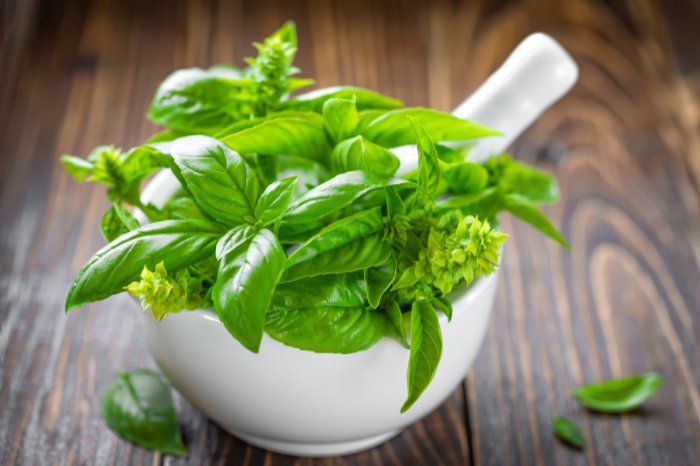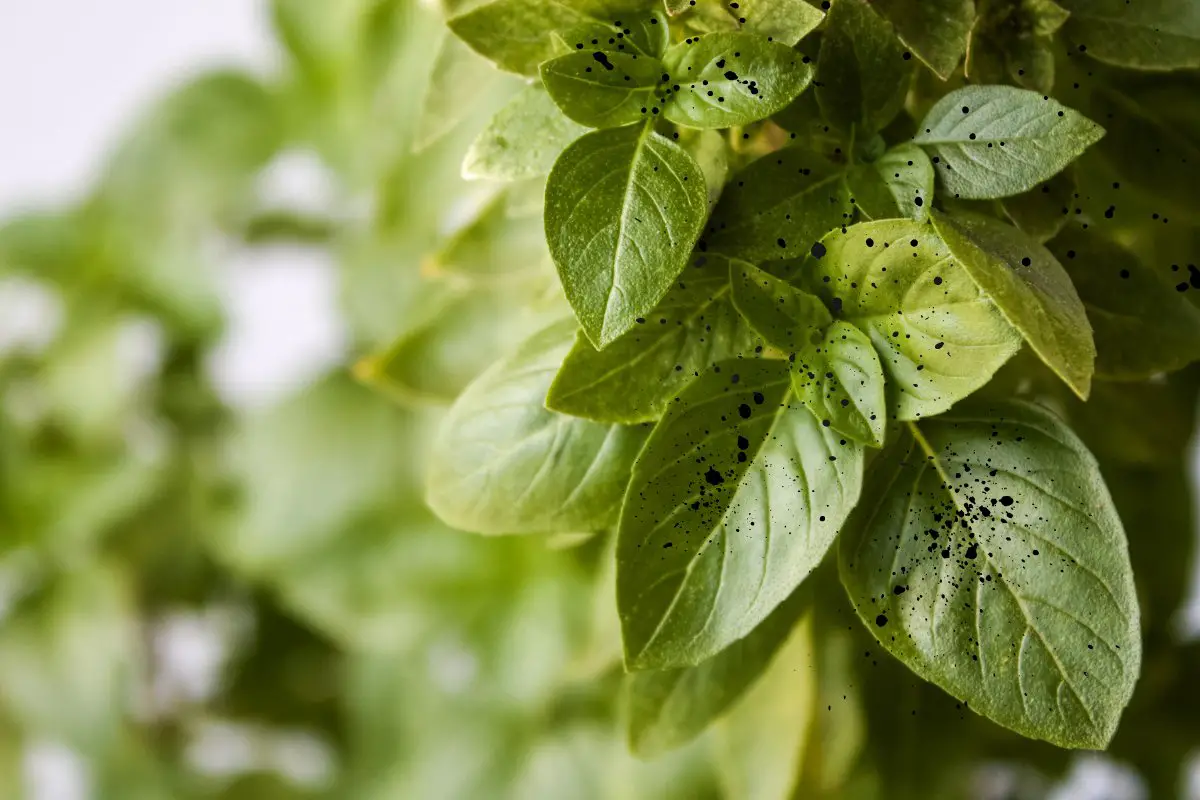Last Updated on December 29, 2022 by Cristina
Basil is one of those must-grow herbs. Black spots on basil leaves are a common problem, and if you know how to avoid them, you will have a year-round supply of basil leaves for your cooking. Read on to find my tips on how to achieve this.
What Is Basil?
More often than not, when we refer to basil we refer to one of the many cultivars of Ocimum basilicum. There are however many many other species of Osimum that are grown, and in some cases can be hybridized to yield all sorts of interesting “basil plants”.
Basil is generally an annual plant – this means that it grows in spring, produces leaves that you can eat in summer, and then flowers in fall and produces seeds and dies. However, there are many hybrid basil cultivars that have been bred that are hybrids between annual and perennial basil, and these produce perennial cultivars that can be grown from cuttings -they generally do not produce seeds.
These perennial basil plants are never quite as yummy as the annual cultivars, so, I advise growing both. The annual basil is your summer treat, and the perennial provides you with fresh basil in winter – if you live in a colder zone, you can grow perennial basil year-round indoors – as long as you give it a bit of supplemental lighting. I live in a relatively mild climate, so I plant perennial basil all over the garden to keep pollinators alive. It is a strong winter flower source to keep leaf cutters and other bees active. These bees are crucial for my winter fava bean crop.

What Causes Black Spots On Basil Leaves?
Basil is a plant that produces a number of terpene flavor compounds, including linalool, eugenol, forms of cineole, limonene, and various others depending on the cultivar. Terpenes are highly bioactive biological compounds with strong anti-fungal, anti-bacterial and anti-insect properties. If your basil plant is not healthy, its ability to protect itself with these compounds is compromised, and the result is that it will become diseased, and not taste very good! A common symptom of a diseased basil plant is black spots on the leaves.
Temperature
If your temperatures drop below 50°F or so, the leaves will turn purple and then black. This is because the plant struggles to move nutrients from its roots at lower temperatures, and also because the leaves can actually just die. If you have a perennial basil plant, it can tolerate lower temperatures, but it is a good idea to move it indoors when it gets colder than 50°F as they tend to get very yellow or die.
In my experience with sweet basil, it tends to go hopelessly into flower long before it gets a chance to develop black spots in its leaves from cold. As the days shorten, basil automatically flowers. You can cut the flower off, and it will bush out more and more, but eventually, you cannot stop the flowers. Let it have its moment of happiness flowering, and then keep the dry basil plant to put in the coals in your weber at the end of the cooking cycle to flavor the food with delicious herb smoke.
Leaf Miners
These are pests that burrow around inside your plant’s leaf and leave little yellow trails, and, over time these trails get infected with fungus and bacteria and become a mess. I have NEVER seen this happen on a healthy basil plant that has enough sunlight and is in healthy soil. This is quite simply because the terpenes in a healthy basil plant will inhibit the growth of most pests. If your soil is bad, and your plant is weak, then it is inclined to get all sorts of pests. It will not have many terpenes in its leaves and will taste horrible. I have grown basil for close to 30 years and have probably seen one or two leaf miners in this time! Those were always in plants that were in bad soil.
There is a rule in life – start right, end right. If you start with good soil, your basil plant will probably be healthy enough to defend against most pests – and as a result, it will taste good.
Bacterial Disease
Basil plants produce terpenes that inhibit bacterial growth. That is something they do well when healthy. These are plants that like well-drained soil that is rich in compost. They are relatively heavy feeders as they get larger, and providing a bit of supplemental feeding is always wise. In my case, I put manure compost mulch over the top layer of soil and give them a teaspoon or spike of bone meal every second month. Mulch is always good.
Ribbon Organics OMRI Certified Organic Compost Size: 7.9 Gallons
If the plants are drowning in water – if you overwater the plants -then the soil will basically start to rot and use up oxygen, and then the roots drown and rot and the plant becomes very stressed. Somewhere along this path, there is a potential for the leaves to get bacterial diseases – if this happens a range of symptoms can occur, but often you will find the leaves get slimy patches in them that rot out and go black. This can cause black spots on basil leaves. Again, prevention is better than cure – good soil, and do not overwater your plants! Give them sunlight and they will not develop these problems.
Click Here to Get Info About:
Black Spots On Basil Leaves Caused By Fungus
Fungi can cause black spots on basil leaves. Again, as stated before, the terpenes in basil leaves that give them the flavors that we are after help to inhibit fungi. If your basil plants are sickly and weak, they will get fungi.
Basil plants tend to thrive in dry Mediterranean-type environments – so, if you are in a humid area, rather grow the basil indoors on a windowsill where you can control the humidity. If you live in a tropical climate with high humidity, the basil will get fungal problems. It is not adapted to this sort of environment.
I have grown basil in my greenhouse, in very humid warm environments, but in a good well drained humus rich soil, and I never had fungus problems. So I suspect again, to stop fungal issues, start with good soil. Basil is a rapidly growing plant, so if you get it wrong and the plants get fungi, try a better draining soil, and grow again. I would not bother trying to find things to spray on the leaves – you plan to eat these leaves, so rather just get the growing right so that your plants are strong and you do not need to treat the plants.
How To Treat Black Spots On Basil Leaves
All of the causes of black spots on basil leaves can be mitigated by growing the plants in the right soil, at the right temperature, with good sunlight, and avoiding very high humidity. So always make sure you grow the plants in well-drained soil – basil does well in pots. Do not overwater your plants – pots can help with this. If you live in an area with very high humidity, the chances are you have air conditioning in your house – grow the basil indoors on a window sill and it will be exposed to lower humidity and will thrive.
I personally do not believe in spraying ANYTHING on my basil, as it will contaminate the leaves. I just make sure that my soil is healthy, the plants get the right conditions and lots of nutrients, and in this way, you get big juicy basil leaves. I also grow perennial basil which is hardier but does not taste as nice. This basil is very tough and gets no real problems if you feed it well and water it once a week.
Are Black Spots On Basil Leaves Safe To Eat?
Black spots on basil leaves can be caused by a number of factors that all indicate poor plant health. My general advice would be if you start seeing a lot of black spots on your basil leaves, just kill the plants, and dry them – you can use these to place on charcoal at the end of a barbeque to make nice smoke for your food. Plant fresh basil in good soil, and then the black leaves will not be a problem. Good soil, good sunlight, medium to low humidity, and moist but not waterlogged soil ensures healthy delicious basil that tends to be problem free. Eat healthy basil!!
In Conclusion – Black Spots On Basil Leaves
As we have shown, black spots on basil leaves are a symptom of an unhealthy plant. If you give your plant the right conditions, it will thrive and there will be no black spots. Avoid low temperatures ideally 65-80°F is a nice range for really healthy leaves. Ensure that the soil is well-drained and rich in compost and nutrients. Avoid high humidity – if you live in a very humid area, grow your basil in windowsill pots indoors where the aircon keeps the humidity down. A healthy basil plant, in healthy soil and at the right temperature will hardly ever develop any black spots – because the terpenes that make basil taste like basil are strong inhibitors of insects, fungi, and bacteria. If your basil is not healthy, it will not produce enough terpenes and it will get sick. So, now you know how to avoid black spots on basil leaves.
Dr. Garth A. Cambray is a Canadian/South African entrepreneur and beekeeper with 28 years of experience in apiculture and specializes in adding value to honey. His Ph.D. research developed a new advanced continuous fermentation method for making mead that has resulted in a number of companies globally being able to access markets for mead. His company, Makana Meadery, exports honey mead to the USA where it is available to discerning connoisseurs. He has also developed technologies to commercially manufacture organic honey vinegar in Zambia for export globally. He holds a few patents globally in the ethanol industry and believes in technology and knowledge transfer for human development and environmental sustainability. One of his proudest achievements is the fact that the wind farm he started at one of his old apiary sites has essentially made his hometown carbon neutral.


